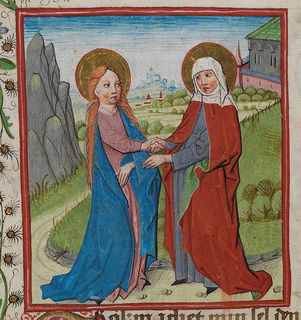
Although the Feast of the Visitation (May 31) is not given special emphasis in the Sulpician liturgical calendar, it is nevertheless a celebration consonant with the ideals of founder of the Sulpician, Father Jean-Jacques OLIER.
This feast is rooted in the biblical account narrated in Luke’s Gospel of the visit Mary made to her relative, Elizabeth, after her miraculous conception of Jesus (Luke 2:39-45). Elizabeth herself, despite her old age, had conceived a son who would be known as John the Baptist and would be the precursor of Jesus, the Messiah.
A distinct feature of Father Olier’s spirituality, which he shared with other members of the so-called French School of Spirituality, is his devotion to the Blessed Virgin Mary. All elements of Mary’s life were important to Father Olier, and many of his writings expound many aspects of Mary’s life as giving a model for priests and seminarians. In the Visitation one sees an encounter between two humble women who were both touched by God’s grace, but in different ways. Mary, the recipient of the greater revelation in bearing the Word-Made-Flesh, the Savior of the World, visits her kinswoman to share her joy. In response, the baby in Elizabeth’s womb leaps for joy, a sign of the greatness of Mary’s Son.
In several texts, Father Olier draws attention to Mary as a “tabernacle” or “receptacle” for the Most High, Jesus Christ, her Son. His famous prayer, now known as the Prayer of Father Olier, begins with the words: “O Jesus, living in Mary, come and live in your servants….” This is an acknowledgment that Mary, bearer of the Incarnate Word, is the sacred vessel who brought forth the Savior for all humanity and who can now dwell within His servants, especially priests, who continue to bear him to the world. She is an essential element in the mystery of the Incarnation. Her “Visitation” brings forth joy and prepares for the apostolic mission.
The Visitation began to be celebrated first among Franciscans in the thirteenth century. But it quickly gained popularity. In 1389, Pope Urban VI instituted the feast for the universal Church. The feast, now celebrated on 31 May, is situated between the Annunciation (March 25) and the feast of John the Baptist (June 24), following the biblical sequence of events.
May this feast of the Visitation inspire all disciples of Jesus Christ to bear Him and His message of salvation to the all the world!


